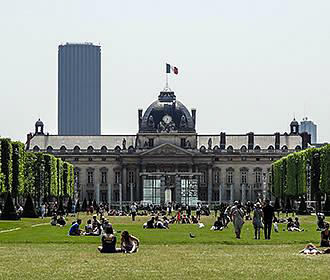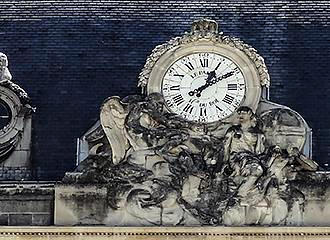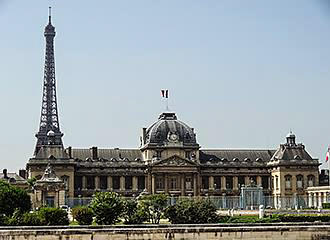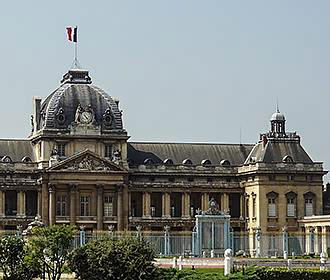Paris Ecole Militaire historical military school
The Paris Ecole Militaire was constructed as a military training school and still has the same purpose today, although it is now called the School of War, and this monument in Paris with its impressive facade is located right by the Champ de Mars and the Eiffel Tower.
About the Paris Ecole Militaire historical military school
The idea to first found a military school for you gentleman from poorer families and those without means was first thought of back in 1750 by Madame and Marquise de Pompadour along with the financier, Joseph Paris Duverney.
This was discussed with King Louis XV who agreed, especially after the lacklustre victory in 1748, and he signed the edict for such a school to be constructed in the January of 1751, and the site chosen was close to Les Invalides on grounds that were designated for vegetable farming at that time.
Ange-Jacques Gabriel, who is also sometimes known as Jacques-Ange Gabriel, was the chief architect for King Louis XV and he was chosen to design the Paris Ecole Militaire. And this incredible French architect also went on to design some other famous and historical buildings in Paris such as the Hotel de Crillon at the Place de la Concorde and the Petit Trianon at the Chateau de Versailles.
But getting back to the Paris Ecole Militaire, construction was started in 1752 and the first pupils were admitted to the military school in 1760, even though the building was far from complete, yet because the Champ de Mars, which had been vegetable gardens, became a military training ground, so the main facade of the buildimg was designed to face this way.
Yet the grand scale of the original designs, which Ange-Jacques Gabriel had produced to outstrip Les Invalides, had been scaled down many times due to lack of funds. And so, even when the chapel was constructed, this was then integrated into the centre of the building, and eventually the first part of the construction of this complex was fully completed in 1773 even though pupils were already there several years prior.
In 1777, the Paris Ecole Militaire was reorganised and named the Ecole des cadets-gentilshommes, which generally translates in English to the School of young gentleman, and this is where Napoleon Bonaparte studied in 1784.
The Ecole Militaire military school closed in 1787, but in 1795 Napoleon Bonaparte came back to the school where he established his command headquarters and then became home to the Imperial Guard a few years later.
However, when you look at this magnificent building, you will see two wings or pavilions as they are known, one bearing the name Cavalry and the other stating Artillery, but these were only added during the Second Empire.
Becoming a military training school once more, it eventually had a name change to the Ecole de Guerre, or School of War, and even today it enrols junior officers from the French forces and other allied countries to train in defence, joint warfare, international relations, etc.
Attendance to the school through a competitive examination is normally a necessary step to achieve a field officer position, and although the official name of the school has changed, it is still referred to as the Paris Ecole Militaire.
Discovering the Paris Ecole Militaire historical military school
Unfortunately, the inside of the Paris Ecole Militaire is not normally open to the public, unless you have prior written authorisation or there is a special event taking place, however, there is still much to admire on the outside of this building and historical Paris monument.
You can discover the central part of the front facade of the Ecole Militaire that faces the Champ de Mars park, with its porch that has eight Corinthian columns, which supports a pediment and an entablature that holds four statues representing Victory, Peace, France and Power.
Not forgetting the impressive pavilion dome with its original clock, which was produced by the French clockmaker Jean-Andre Lepaute back in the 1700s, and this masterpiece is still keeping time today.
Yet in front of this facade you can see an equestrian statue of Joseph Joffre, who was a Marshal and French General during World War I, and the area in front of the Ecole Militaire has been renamed the Place Joffre in his honour.
By going round to the back of the Paris Ecole Militaire, by the Place de Fontenoy with the Eiffel Tower looming up behind, you can also get to see the double colonnades that are located either side of the pavilion dome, again with a Lepaute clock, and it is via this entrance that you would reach the Cour d’Honneur.
Now because of its location close to some of the most famous Paris tourist attractions, getting to the Ecole Militaire is very easy via Paris public transport, and the nearest Metro station is called the Ecole Militaire stop via line 8.
However, in the opposite direction you have the La Motte-Picquet - Grenelle Metro stop serving lines 6, 8 and 10, yet there is also the Champ de Mars - Tour Eiffel train station for the RER trains via the RER C Line.
Yet the Paris bus Lines 28, 42, 69, 80, 82, 87 and 92 will get you close by, as will the Batobus water bus, which has a stop at the foot of the Eiffel Tower by the Pont d’Iena bridge, plus there are numerous tours in Paris such as the Paris Tootbus Tours that have a stop close by.



